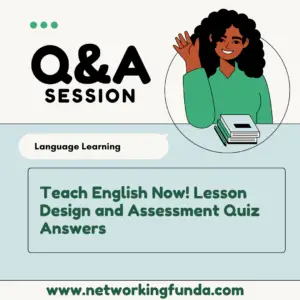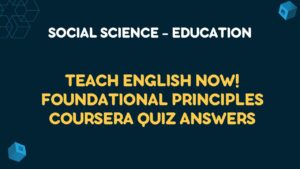All Weeks Managing Emotions in Times of Uncertainty & Stress Quiz Answers
Table of Contents
Managing Emotions in Times of Uncertainty & Stress Week 01 Quiz Answers
Quiz :Why Emotions Matter
Q1. When we are experiencing certain emotions, we tend to seek out more innovative solutions to our problems.
This is an example of how emotions affect which of the following? (Choose the best answer.)
- Attention, memory, and learning
- Decision making
- Relationships
- Physical and mental health
- Creativity and performance
Q2. When we are anxious or even excited about something in the future, we may have a hard time focusing and processing new information.
This is an example of how emotions affect which of the following? (Choose the best answer.)
- Attention, memory, and learning
- Decision making
- Relationships
- Physical and mental health
- Creativity and performance
Q3. Research shows that how teachers feel affects the grades they assign to their students’ work.
This is an example of how emotions affect which of the following? (Choose the best answer.)
- Attention, memory, and learning
- Decision making
- Relationships
- Physical and mental health
- Creativity and performance
Q4. Emotions are signals. What we see in other people’s faces and body language tells us to approach or to avoid.
This is an example of how emotions affect which of the following? (Choose the best answer.)
- Attention, memory, and learning
- Decision making
- Relationships
- Physical and mental health
- Creativity and performance
Q5. Chronic stress can impair the function of our immune system.
This is an example of how emotions affect which of the following? (Choose the best answer.)
- Attention, memory, and learning
- Decision making
- Relationships
- Physical and mental health
- Creativity and performance
Managing Emotions in Times of Uncertainty & Stress Week 02 Quiz Answers
Quiz :Defining Thought Strategies
Q1. Which strategy involves acknowledging the things that we’re thankful for, whether those are people, experiences, or causes?
- Compartmentalize
- Find passion and purpose
- Mindfulness
- Savor the good
- Focus on gratitude
Q2. Which strategy involves the practice of paying attention to our minds and bodies without judging them?
- Mindfulness
- Find passion and purpose
- Savor the good
- Focus on gratitude
- Compartmentalize
Q3. Which strategy involves setting aside a specific time to devote to dealing with unwanted feelings?
- Focus on gratitude
- Find passion and purpose
- Savor the good
- Compartmentalize
- Mindfulness
Q4. Which strategy involves noticing how pleasant emotions feel in our bodies, hearts, and minds?
- Mindfulness
- Compartmentalize
- Find passion and purpose
- Focus on gratitude
- Savor the good
Q5. Which strategy might involve seeing how your role at your school contributes to the greater good?
- Mindfulness
- Find passion and purpose
- Compartmentalize
- Savor the good
- Focus on gratitute
Managing Emotions in Times of Uncertainty & Stress Week 03 Quiz Answers
Quiz :Review Key Concepts
Q1. Which of the following is an example of ethnocentrism?
- A group of American teachers and students spend spring break in South America, learning about different plants and species native to that area. When they return, they present their interesting findings and takeaways to the entire student body.
- A group of students search “weird food eaten in other countries” on Google. They make disgusted facial expressions and laugh as they learn about customary delicacies around the world.
- When an Australian exchange student mentions that they drive on the left side of the road back home, the other students start laughing and making jokes. “That’s so weird,” one says. “How can anyone drive on the wrong side of the road?”
- An elementary school celebrates “World Culture Day,” when students are asked to bring in different items that represent their culture.
Q2. Which of the following examples best describes fundamental attribution error?
- A teacher expresses disappointment in the class average for a test, saying that a lack of studying is to blame. However, students blame the teacher for not providing a detailed study guide.
- A teacher confuses one student for another while taking attendance.
- A student blames her teacher after receiving a bad grade on a test, even though the student knows she didn’t study as much as she should have.
- A student raises his voice angrily in response to being disciplined, and the teacher attributes it to his disrespectful personality. Later in the day, the same teacher raises his voice angrily in a meeting but attributes it to the instigating behavior of a colleague.
Q3. Which of the following examples reflect the concept “behavior doesn’t equal emotion”?
- A high school student jumps up and starts yelling after being assigned detention. The teacher assumes that she is angry about being disciplined. However, the teacher later realizes that the student was frightened about the punishment that her parents had threatened if she received another detention.
- A young student begins to cry when another student takes away his favorite toy. He tells the teacher that he is sad because the other student didn’t ask first.
- When the principal announced the recipient of a prestigious award, I smiled and congratulated the recipient. Despite the smile, I felt crushed, sure I would receive the award this year.
- A student wants to hug a classmate on her birthday, but the teacher explains that students need to maintain safe social distancing. The student looks down and frowns. “I wish I could hug my friend,” she says sadly. This should not be selected
Q4. Which of the following is an example of coregulation?
- Two students have a similar emotional reaction to a video shown in class.
- During an afternoon class, students have high energy levels and are particularly chatty. The teacher is struggling to focus the class.
- In a staff meeting to discuss safe back-to-school protocols, staff members seem nervous. The principal begins the meeting by assuaging concerns and commending staff on their dedication to student success. Staff members feel more at ease as they begin the meeting. Correct
- After a student enters class crying, the teacher pulls her aside, asking what’s bothering her in a caring and soft tone. The teacher performs a brief breathing exercise with the student to help calm her down. Correct
More related Quiz Answers >>
Convolutional Neural Networks in TensorFlow
Natural Language Processing in TensorFlow
Sequences, Time Series, and Prediction



